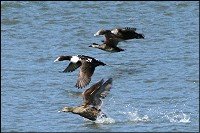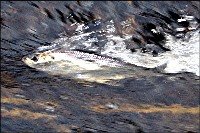I began yesterday with a goal in mind: to see if the Mayflower blossoms I had seen last week were now in bloom. This was primarily first on  my spring checklist for the day but also I had been hoping to see Yellowlegs and Green-winged Teal as well. As there has been a lot of flooding activity this week, along the Saint John and it tributaries, due to snow and ice melt, I first decided to check out an area that most always floods each spring and ducks often gather there in the fields covered with water. I was immediately rewarded with seeing a small flock of Canada Geese at the edge of the rising waters, but the gold in this sighting was a glimpse of three Green-winged Teal in the water behind them! While checking the area with my binoculars I saw a beautiful Northern Harrier flying over the area but its flight path was further than my camera lens would
my spring checklist for the day but also I had been hoping to see Yellowlegs and Green-winged Teal as well. As there has been a lot of flooding activity this week, along the Saint John and it tributaries, due to snow and ice melt, I first decided to check out an area that most always floods each spring and ducks often gather there in the fields covered with water. I was immediately rewarded with seeing a small flock of Canada Geese at the edge of the rising waters, but the gold in this sighting was a glimpse of three Green-winged Teal in the water behind them! While checking the area with my binoculars I saw a beautiful Northern Harrier flying over the area but its flight path was further than my camera lens would  reach. Upon checking the flooded fields on the other side of the highway I saw at a great distance some Black Ducks and feeding in between them was a Yellowlegs! Its profile allowed me to identify it as such, but not as far as if to say it was a greater
reach. Upon checking the flooded fields on the other side of the highway I saw at a great distance some Black Ducks and feeding in between them was a Yellowlegs! Its profile allowed me to identify it as such, but not as far as if to say it was a greater .jpg) or lesser one. My next stop was to check on the Mayflowers, and I easily found several in bloom. This day was full of interest -ing sightings for me for when I returned home I saw a Goldfinch in our feeder area. Usually a Goldfinch isn't such an uncommon
or lesser one. My next stop was to check on the Mayflowers, and I easily found several in bloom. This day was full of interest -ing sightings for me for when I returned home I saw a Goldfinch in our feeder area. Usually a Goldfinch isn't such an uncommon  sighting for me but for some reason this past fall and winter there just didn't seem to be any around. This Goldfinch was the first I had seen for many, many months. It was a very welcome sight. This had been a very rewarding day with quite a growing collection of interesting first spring sightings but it was not yet over for while out on an afternoon walk
sighting for me but for some reason this past fall and winter there just didn't seem to be any around. This Goldfinch was the first I had seen for many, many months. It was a very welcome sight. This had been a very rewarding day with quite a growing collection of interesting first spring sightings but it was not yet over for while out on an afternoon walk  I came across a caterpillar in damp grass in a large meadow. I haven't tried to id it yet, but most significant to me is that I don't think I've ever come across one so early in the year before. It continued to be a wonderful day of sightings for early in the evening I went out to fill the car with gas and decided to take the long way home as the evening light was so beautiful. Driving by a
I came across a caterpillar in damp grass in a large meadow. I haven't tried to id it yet, but most significant to me is that I don't think I've ever come across one so early in the year before. It continued to be a wonderful day of sightings for early in the evening I went out to fill the car with gas and decided to take the long way home as the evening light was so beautiful. Driving by a small pond I spied what I thought at first were Black Ducks as they were in the shadows, but closer examin -ation showed them to be a couple of female Mergansers near the edge of the pond.
small pond I spied what I thought at first were Black Ducks as they were in the shadows, but closer examin -ation showed them to be a couple of female Mergansers near the edge of the pond.  Aren't they beautiful? And then; what could be a more perfect ending to a perfect day of nature sightings than a meadow full of White-tailed Deer, eight in all.
Aren't they beautiful? And then; what could be a more perfect ending to a perfect day of nature sightings than a meadow full of White-tailed Deer, eight in all.
 An outstanding feature of this dabbling duck, that is so readily observable, is its long spatulate bill. The Northern Shoveler skims the water for food
An outstanding feature of this dabbling duck, that is so readily observable, is its long spatulate bill. The Northern Shoveler skims the water for food  and comb like projections along the side of its bill allows the food to remain while the water sieves out. The female Shoveler is very similar in appearance to the female Mallard Duck but as with the male, the long bill sets it apart and gives it its own distinctive identifying feature.
and comb like projections along the side of its bill allows the food to remain while the water sieves out. The female Shoveler is very similar in appearance to the female Mallard Duck but as with the male, the long bill sets it apart and gives it its own distinctive identifying feature. 

.JPG)
.JPG)
.jpg)
.JPG)
.JPG)
.JPG)

.JPG)


%5B1%5D.jpg)
.JPG)
.jpg)





.jpg)



.jpg)




.JPG)
.JPG)
.JPG)
.JPG)

.JPG)
.JPG)
.JPG)
.JPG)
.JPG)
.JPG)

.JPG)
.jpg)
.JPG)


.JPG)


.JPG)
.jpg)













